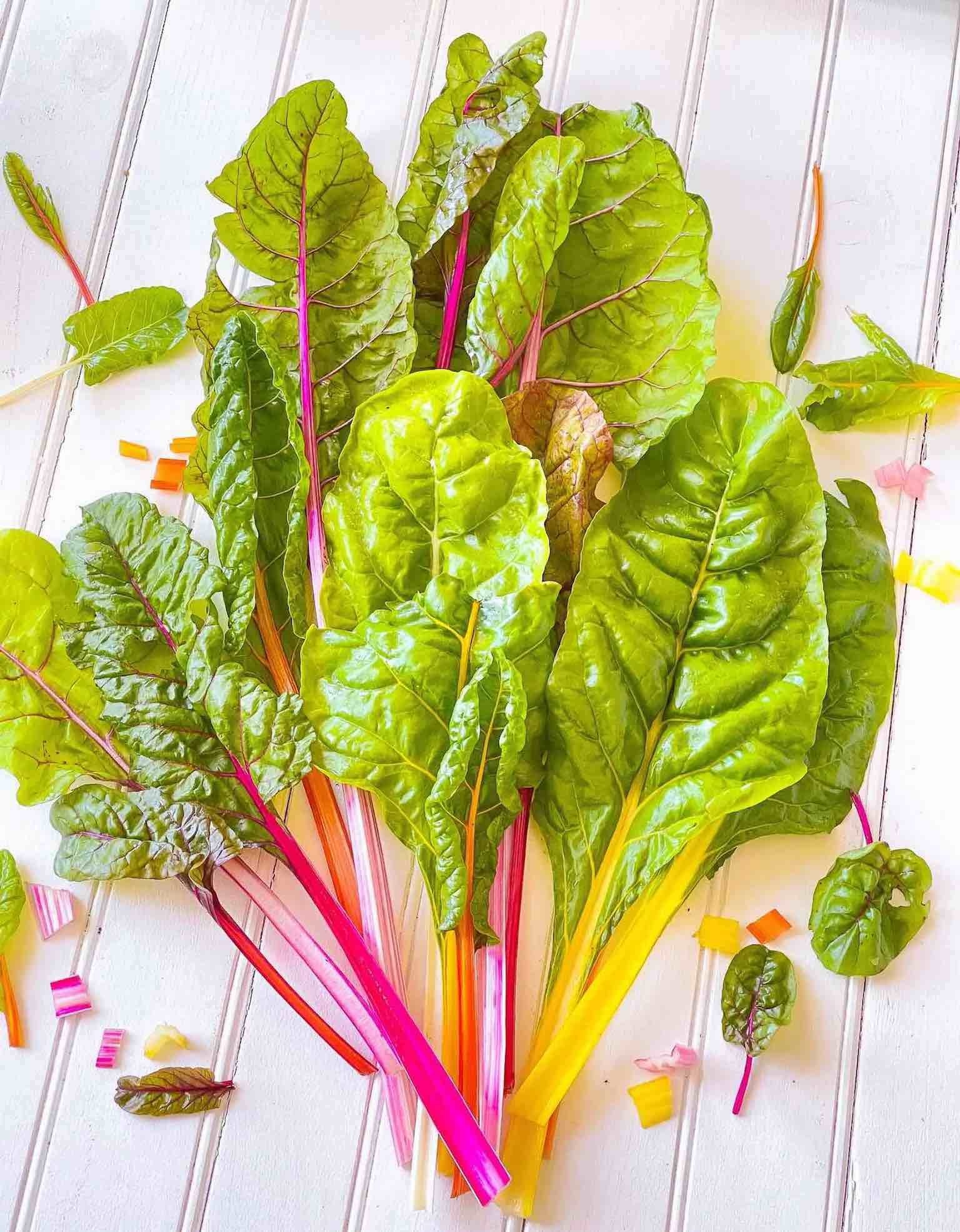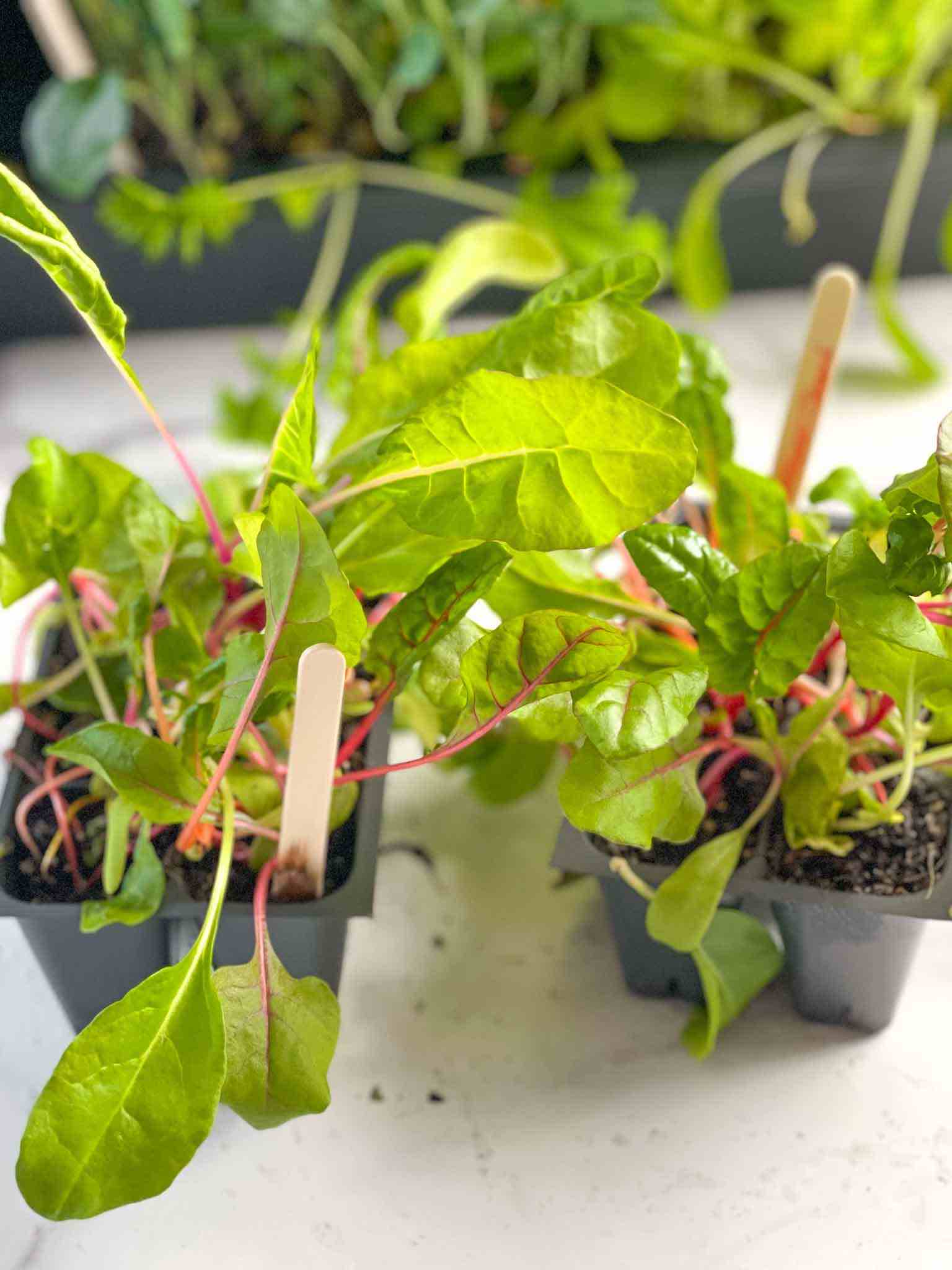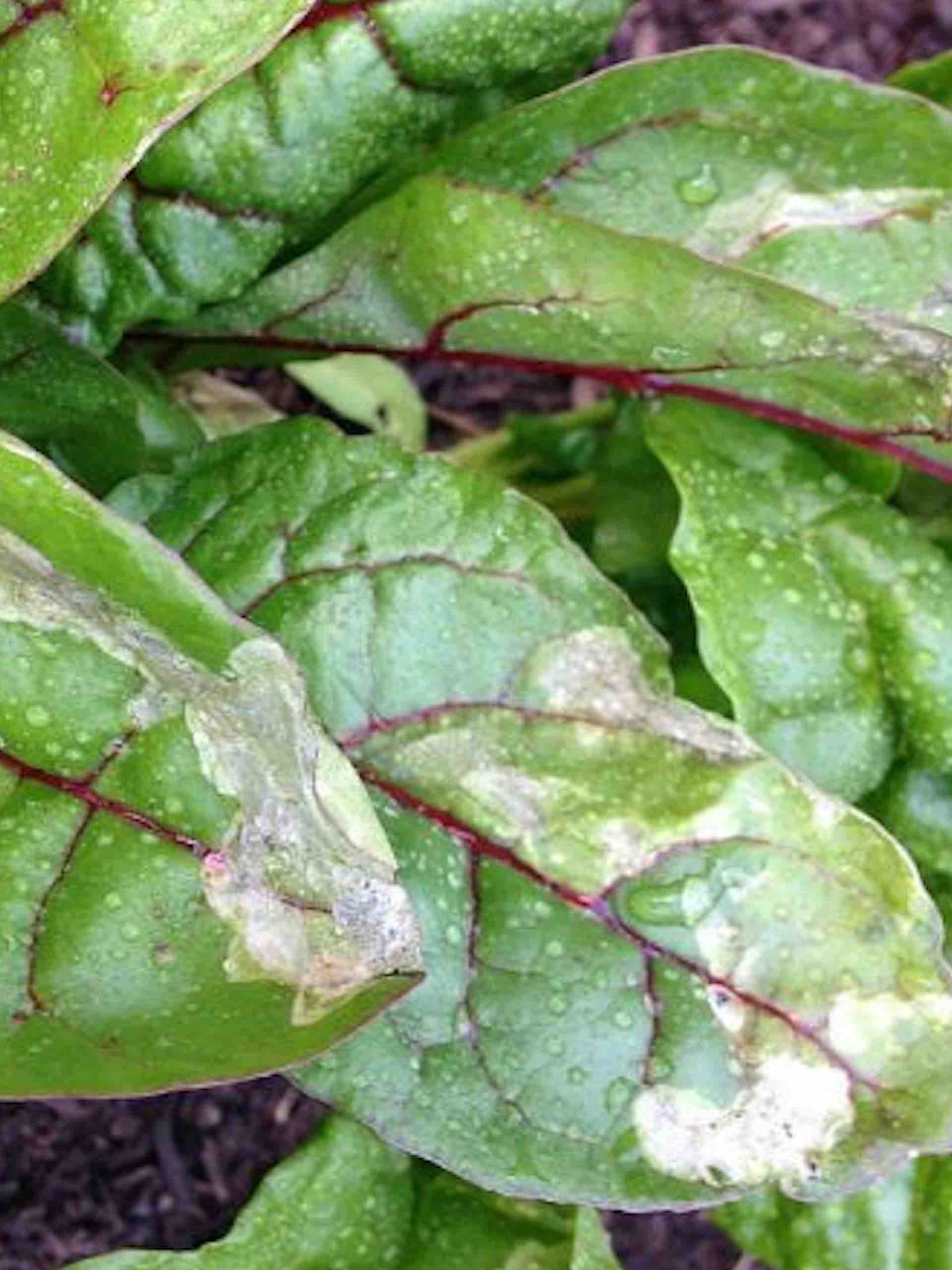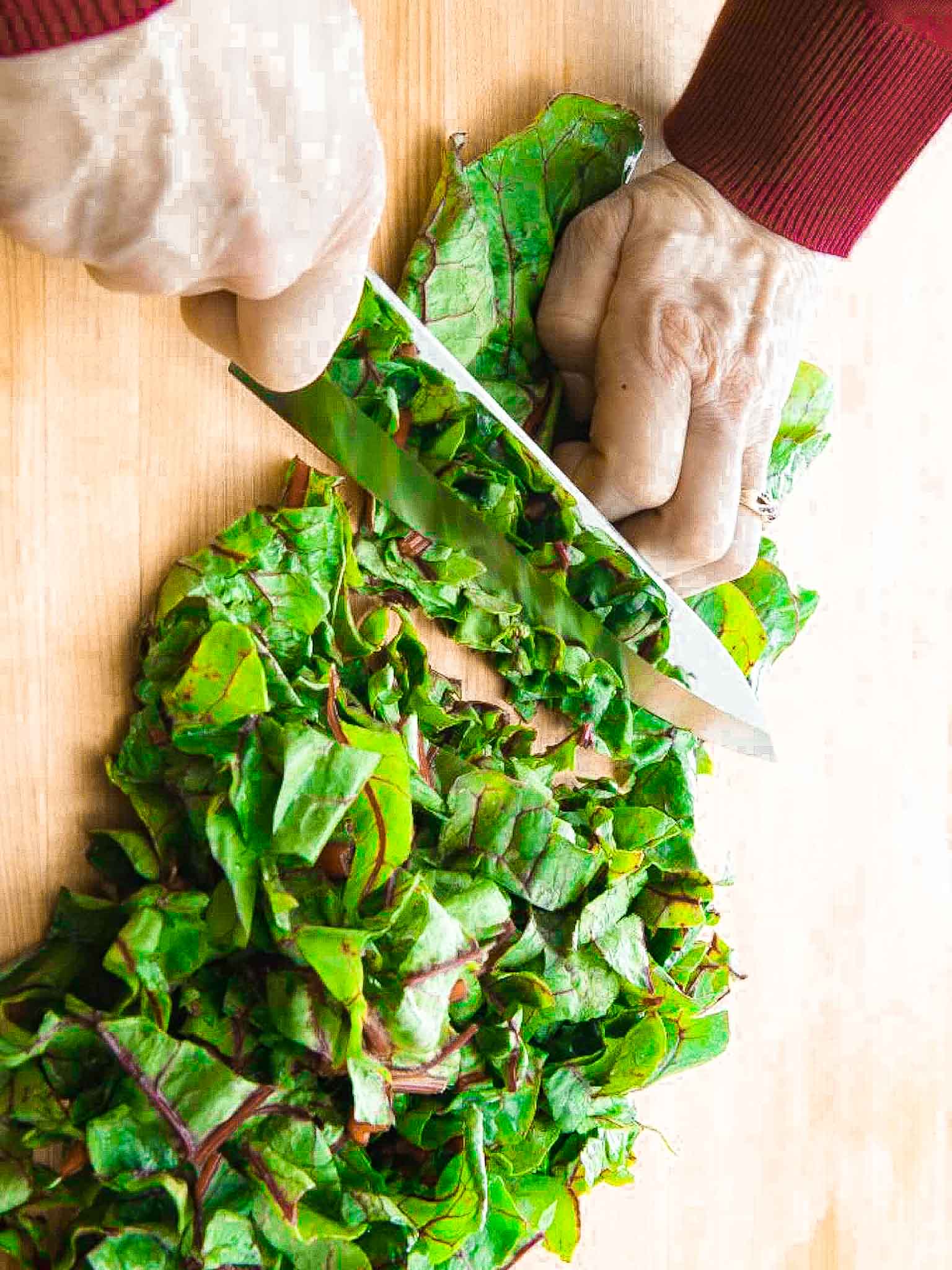GROWING AND PREPARING SWISS CHARD
Sturdier than spinach and more delicate than kale, Swiss chard is a nutritional powerhouse, not to mention it’s colorful and beautiful!
![]()

My garden wouldn’t be the same without Swiss chard – Bright Lights variety. I love growing this beautiful green and seeing it every morning. It reminds us of the natural beauty of nature! Nothing else is required! Swiss chard has a prominent spot in my cool Spring garden, which includes 18 separate plantings including greens, brassicas, snap peas, herbs, and more. You can see the layout, seed choices, and each planting here on the Garden to Table section.
Bright Lights Swiss chard is a specific variety of Swiss chard that is renowned for its stunning and vibrant colors. The leaves of Bright Lights Swiss chard come in a rainbow of hues, including shades of red, pink, yellow, orange, and even white. This variety adds a burst of visual appeal to any garden and can make your dishes more visually enticing.
Are you looking for a versatile and nutrient-packed addition to your garden and dining table? Look no further than Swiss chard! This vibrant leafy green vegetable, known for its robust flavor and stunning colors, is a favorite among health enthusiasts and gardeners alike. In this blog post, we will explore the reasons why you’ll fall in love with Swiss chard, offer valuable growing tips, discuss common pests and bugs to watch out for, and provide some mouthwatering serving suggestions. Get ready to discover the wonders of Swiss chard and elevate your culinary experience!

Reasons You’ll LOVE Swiss Chard
You’ll become a believer in no time!
Swiss chard is an incredibly versatile and nutritious leafy green vegetable that offers numerous reasons to love it. Here are some compelling reasons why Swiss chard deserves a special place in your garden and kitchen.
-
- Nutritional Powerhouse – Swiss chard is packed with essential vitamins, minerals, and antioxidants that contribute to overall health and well-being. It is an excellent source of vitamins A, C, and K, which support healthy vision, immune function, and bone health. Additionally, Swiss chard contains minerals like magnesium, potassium, and iron, which are vital for various bodily functions.
- Vibrant and Colorful – Swiss chard’s vibrant colors, especially in varieties like Bright Lights, add a visual delight to your garden and plate. The beautiful hues of red, pink, yellow, orange, and white make it an aesthetically pleasing addition to any meal or salad.
- Versatile in the Kitchen – Swiss chard offers endless culinary possibilities. You can enjoy it raw in salads, lightly sautéed as a side dish, stir-fried with other vegetables, or incorporated into soups, stews, and casseroles. Its tender leaves and crunchy stalks provide a delightful texture and a unique flavor that can enhance a wide range of dishes.
- Easy to Grow – Swiss chard is a resilient and low-maintenance vegetable, making it an excellent choice for gardeners of all skill levels. It grows well in various climates and can tolerate both cool and warm weather. Whether you have a large backyard garden or a small container garden, Swiss chard can thrive and produce a bountiful harvest with minimal effort.
- Continuous Harvest – One of the remarkable features of Swiss chard is its ability to provide a continuous harvest. By regularly harvesting the outer leaves while allowing the inner leaves to grow, you can enjoy a steady supply of fresh Swiss chard throughout the growing season. This makes it a valuable addition to any kitchen garden, ensuring a constant source of nutritious greens for your meals.
- Delicious Flavor Profile – Swiss chard has a unique flavor that is often described as earthy, slightly bitter, and slightly salty. The combination of its tender leaves and crunchy stems provides a pleasant contrast in texture. Whether cooked or enjoyed raw, Swiss chard adds depth and complexity to dishes, enhancing the overall taste experience.
- Health Benefits – Including Swiss chard in your diet offers numerous health benefits. Its high fiber content aids in digestion and promotes a healthy gut. The antioxidants present in Swiss chard help reduce inflammation, protect against oxidative stress, and may lower the risk of chronic diseases such as heart disease and certain cancers.
- Versatile Plant – Swiss chard is not only edible but also a visually appealing plant. Its attractive leaves and colorful stems make it a fantastic ornamental addition to your garden or landscape. You can incorporate Swiss chard into flower beds or use it as an eye-catching border plant, enhancing the aesthetics of your outdoor space.
Swiss chard is a nutritional powerhouse that offers versatility, vibrant colors, and a delightful flavor. Its ease of cultivation, continuous harvest, and numerous health benefits make it a must-have vegetable for both gardening enthusiasts and food lovers. So, whether you’re seeking a nutritious addition to your meals or a visually stunning plant for your garden, Swiss chard is sure to impress and satisfying.

How to Grow Swiss Chard
Growing Swiss chard is a rewarding and straightforward process. Whether you have a large garden or limited space, you can cultivate Swiss chard successfully by following these steps:
-
- Selecting a Planting Location – Swiss chard thrives in full sun but can tolerate partial shade. Choose a location in your garden that receives at least 4-6 hours of direct sunlight per day. Ensure the soil is well-draining, loose, and rich in organic matter. It’s recommended to prepare the soil by incorporating compost or aged manure to improve its fertility and structure.
- Sowing Seeds or Transplanting Seedlings – Swiss chard can be started from seeds or transplants. If you prefer seeds, sow them directly into the garden bed. Plant the seeds about half an inch deep and space them around 2 inches apart in rows. If using transplants, space them 8-12 inches apart. Swiss chard is a cool-season crop, so it’s best to sow seeds in early spring or late summer for a fall harvest.
- Watering – Swiss chard requires consistent moisture to thrive. Keep the soil evenly moist but not waterlogged. Water deeply whenever the top inch of soil feels dry. Avoid overhead watering as it can increase the risk of diseases. Applying mulch around the plants can help retain moisture, suppress weeds, and maintain a more even soil temperature.
- Thinning and Transplanting (if necessary) – Once the seedlings emerge and develop their first true leaves, thin them to allow sufficient space for each plant to grow. Thin the seedlings to around 4-6 inches apart. If you started with transplants, skip this step as they are already spaced adequately.
- Fertilizing – Swiss chard is not a heavy feeder, but applying a balanced fertilizer or compost during planting can provide essential nutrients. A slow-release, organic fertilizer can be used as per the manufacturer’s instructions. Avoid excessive nitrogen fertilizers, as they can encourage excessive leaf growth at the expense of root development.
- Pests and Disease Management – Swiss chard is generally resistant to pests and diseases, but some common issues to watch out for include aphids, flea beetles, and leaf miners. Monitor your plants regularly and take necessary measures such as using insecticidal soap or neem oil to control pests. Proper spacing, good air circulation, and avoiding overhead watering can help prevent diseases.
- Harvesting – Swiss chard leaves can be harvested when they reach a length of 6-8 inches. Start by harvesting the outer leaves, leaving the center leaves to continue growing. Regularly harvesting the outer leaves encourages the plant to produce more foliage. Cut the leaves at the base of the plant using scissors or a sharp knife. The leaves can be harvested at any stage, from baby leaves to full maturity.
Swiss chard is a cut-and-come-again vegetable, meaning it will continue producing new leaves after each harvest, allowing for a continuous supply throughout the growing season.

Swiss Chard Pests and Bugs
While Swiss chard is generally resistant to pests and diseases, it can still encounter a few common insect pests. Here are some pests that may affect Swiss chard and some strategies to manage them:
-
- Aphids – These small, soft-bodied insects can cluster on the undersides of Swiss chard leaves and suck sap from the plant, causing leaf curling and distortion. To control aphids, you can spray a strong stream of water on the leaves to dislodge them or use insecticidal soap or neem oil as a natural insecticide.
- Flea Beetles – Flea beetles are tiny, jumping beetles that chew small holes in the leaves, giving them a “shot-hole” appearance. Floating row covers can be used to prevent flea beetles from reaching the plants. If an infestation occurs, you can apply diatomaceous earth or an insecticidal soap to control them.
- Leaf Miners – Leaf miner larvae create distinctive tunnels or trails in the leaves of Swiss chard. To control leaf miners, promptly remove and destroy any infested leaves. You can also try applying sticky traps near the plants to catch adult flies.
- Slugs and Snails – These slimy pests can feed on the leaves of Swiss chard, leaving behind large holes. To deter slugs and snails, you can create physical barriers such as copper tape or use organic slug pellets sparingly. Beer traps and handpicking can also help reduce their population.
- Cabbage Worms – Cabbage worms, which are the larvae of white butterflies, can munch on Swiss chard leaves, leaving behind irregular holes. Inspect the plants regularly and manually remove any caterpillars you find. Bacillus thuringiensis (Bt), a natural bacterial insecticide, can also be used to control cabbage worms.
It’s important to monitor your Swiss chard plants regularly to detect any pest issues early on. Healthy plants are more resistant to pests, so providing adequate nutrients, proper watering, and maintaining good garden hygiene can help minimize pest problems. Additionally, promoting biodiversity in your garden by planting companion plants that repel pests, such as marigolds or garlic, can be beneficial.
By staying vigilant and taking appropriate measures, you can protect your Swiss chard plants from pests and ensure a healthy harvest of delicious and nutritious greens.

How to Prepare Collard Greens
Preparing collard greens involves a few simple steps to ensure they are clean, tender, and ready for cooking. Here’s a guide on how to prepare collard greens.
-
- Selecting Collard Greens – Choose fresh collard greens with vibrant green leaves that are crisp and free from yellowing or wilting. Look for smaller to medium-sized leaves, as they tend to be more tender and flavorful.
- Washing Collard Greens – Start by washing the collard greens thoroughly to remove any dirt, debris, or potential pests. Fill a large basin or sink with cold water. Submerge the collard greens in the water and swish them around to loosen any dirt or grit. Rinse them under running water to ensure they are clean. Alternatively, you can rinse each leaf individually under running water.
- Removing the Stems – Collard greens have tough stems that need to be removed before cooking. To remove the stems, hold the leaf with one hand and firmly grip the base of the stem with the other. Gently pull the leaf away from the stem, starting at the base and working your way up toward the tip. Discard the stems or save them for composting if desired.
- Preparing the Leaves – Once the stems are removed, stack a few collard green leaves on top of each other. Roll them tightly into a cigar-like shape. Using a sharp knife, slice across the rolled leaves to create thin strips, also known as a chiffonade. Repeat this process with the remaining leaves.

Serving Suggestions for Swiss Chard
Simple to prepare and wonderfully delicious!
-
- Sautéed Swiss Chard with Garlic and Lemon – Simple and delicious. Sometimes this is all I’ll have for lunch!
- Tomato and Canelinni Soup- This recipe comes from my grandmother who was an avid gardener who loved all greens!
- On a salad – I often rough chop my Swiss chard and add them to a simple garden salad. It pairs well with toasted nuts, pasta, rice, and all herbs!


Sautéed Swiss Chard with Garden Fresh Stir Fry
Ingredients
- 2 bunches Fresh Swiss Chard
- Chopped Garlic
- 1 tbsp Olive Oil
- Sea Salt
- Red Pepper Flakes
Stir Fry
- 1 cup Rice
- 1/2 cup Cauliflower Florets
- 1/4 cup Chopped Leeks
- 1/4 cup Broccoli Florets
- 1 med Fresh Red Radish
- 1 cup Chopped Swiss Chard Stems
Instructions
- Chop and clean your Swiss Chard. To cut the Swiss Chard, lay a few leaves on top of each other on the cutting board, and remove the stems. Chop the stems into small pieces for stir fry later.
- Sautee the leeks, garlic, cauliflowers, broccoli, stems.
- Add Swiss Chard - Cover and Wilt. Once the stems and veggies are softened add green leaves at the end, since they don’t need as much cooking time to become tender.
- Soften the Greens. Once the greens are wilted down, remove the lid and continue cooking and stirring until the greens are tender.


0 Comments